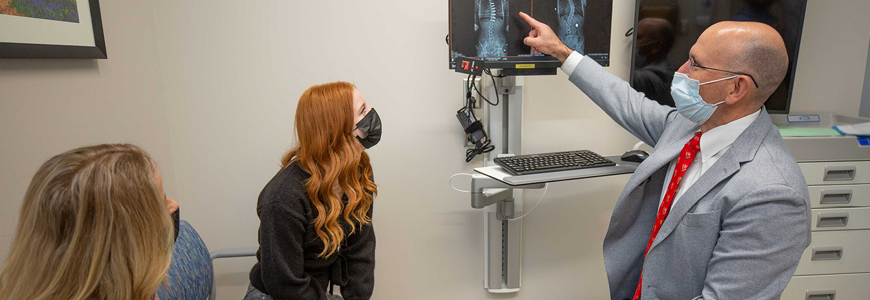Robert K. Lark, MD, MS, is a pediatric spine surgeon and section chief of the Department of Pediatric Orthopaedics at Duke Children’s Hospital & Health Center who finds the resilience of children facing developmental challenges as an inspiration to find ways to offer them the best possible care. In a recent interview, Lark discussed the distinctive approaches that help make Duke one of the leading pediatric scoliosis centers in the Southeast U.S.
What sets Duke apart from other providers in treating scoliosis in pediatric patients?
The three main advantages that make Duke stand out are the level of expertise of our core faculty and supporting staff, the comprehensive and innovative nature of our offerings, and our team approach.
Let’s take those aspects one at a time. What makes the core faculty special?
We have at least four surgeons who have completed dedicated pediatric spinal training and are active members of the Scoliosis Research Society, which differentiates us from any other provider in the state. As participants in the international Pediatrics Spine Study Group, we contribute to and stay up to date on the latest multi-center studies. This training and research participation equip us to develop treatment plans based on the most recent data.
Taken together, our orthopaedics department chair, Benjamin A. Alman, MD; our residency director, Robert D. Fitch, MD; and I have more than 80 years of surgical experience. The newest member of our core team, Anthony A. Cantanzano, Jr., MD, completed a five-year residency in orthopaedic surgery, followed by a fellowship in pediatric orthopaedic surgery. As a tertiary referral center, we are accustomed to treating patients with the most complex conditions and offer the improved outcomes associated with a high volume of both surgical and nonsurgical treatments.
Can you give examples of Duke’s comprehensive and innovative care?
Treating scoliosis in children is very challenging, so we constantly search for the latest surgical and nonsurgical treatments. We offer two relatively new surgical treatments. One is particularly helpful in treating patients under 10 years old with early-onset scoliosis. The MAGEC system (NuVasive, San Diego, CA) involves implanting rods that can be adjusted using magnetic technology as the child grows to reduce the need for multiple surgeries. The other is anterior vertebral tethering, which uses implants that encourage the spine to grow out of the scoliosis. This technique preserves the spine’s ability to move, so in some cases it is preferable to the commonly used spinal fusion. Another new technique we are considering is called ApiFix (Orthopediatrics, Warsaw, IN), which uses a posterior distraction device to correct scoliosis in adolescents.
What about nonsurgical treatment?
Of course, Duke offers standard bracing techniques, but we were also early adopters of the Schroth method of physical therapy. In this method, we study the patient’s unique spinal curve pattern in order to design patient-specific exercises to treat it. The physical therapists need a great deal of extra training to be qualified to offer the technique. It is a testament to the dedication of our nonsurgical staff that we have two physical therapists who have taken the time to achieve this certification. Additionally, we were fortunate to take our team to Germany for a bracing and therapy course by Manuel Rigo, MD, PhD, an internationally recognized non-operative scoliosis specialist. Our therapists are currently helping us conduct a study assessing the effect of non-operative treatments on functional motion and balance in patients with scoliosis.
Have there been innovations in diagnosis?
We were the first center in North Carolina to introduce the low-radiation-dose imaging system called EOS (ATEC Spine, Carlsbad, CA). It produces high-quality, three-dimensional, full-body images with a tenth of the radiation dose of conventional chest X-ray and much less than computed tomography, which is an especially important consideration when treating children who will undergo lots of imaging. We now have four of these machines across the Duke platform.
What can you say about the team approach?
As one of the first centers in the U.S. to be designated a Level 1 Pediatric Surgical Center by the American College of Surgeons, we have access to any additional expertise needed. For example, we can bring in a cardiothoracic surgeon to assist in operations such as tethering. When treating children with complex medical conditions, our teams make sure the patients are medically optimized prior to surgery and receive excellent care from specially trained pediatric providers in the hospital after a big event like a spine surgery.
To refer a patient, call 919-613-7797.
